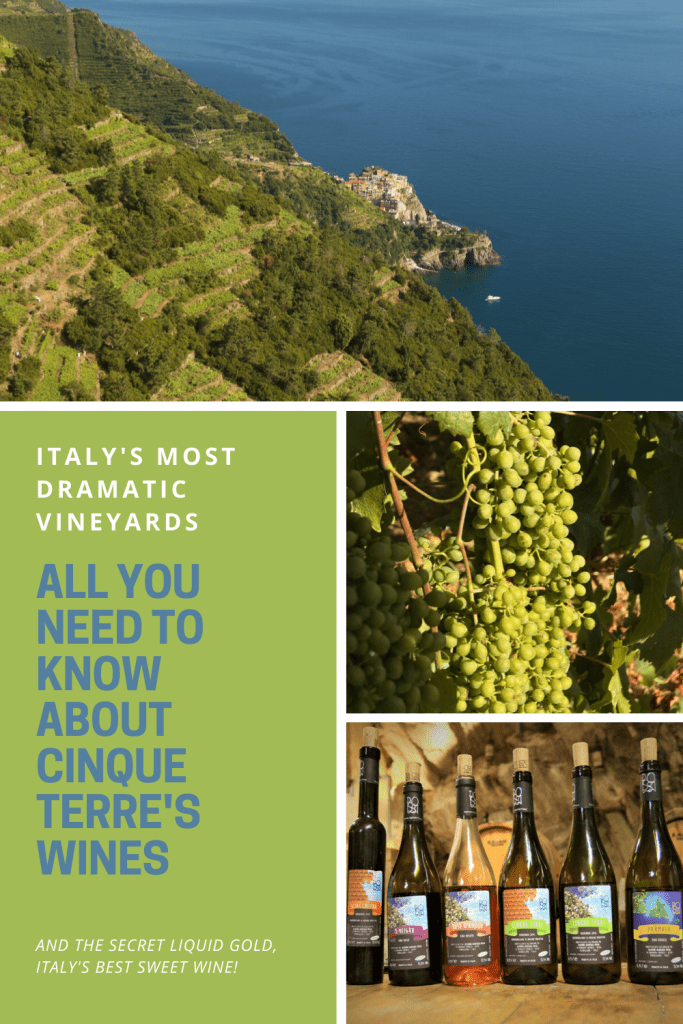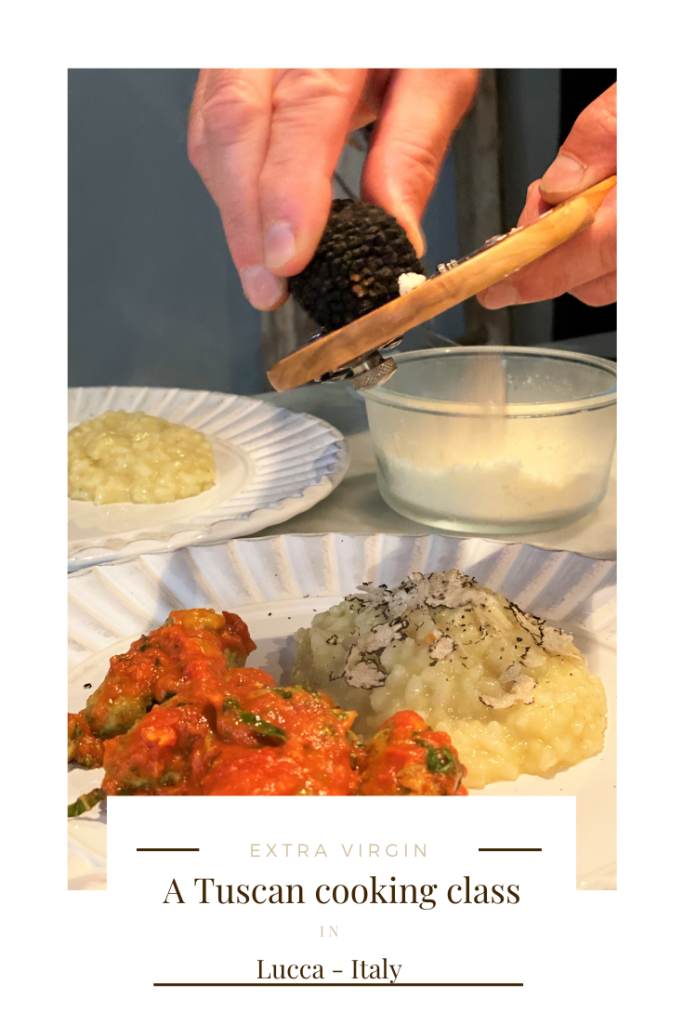Text: Claire Lessiau & Marcella van Alphen
Photos: Claire Lessiau & Marcella van Alphen
With about 1.5 million inhabitants, the capital of Liguria, squeezed between the Gulf of Genoa and the mountains, is the 5th city of Italy and the busiest of the Mediterranean Sea extending for 15 kilometres along the coast. Off the beaten path destination more known today for its industrial and logistic sides than for its tourist attractions, Genoa was nicknamed La Superba when it used to rule as one world’s most powerful Maritime Republics. Known since the Middle-Ages for its ability to navigate the seas, to build alliances and to develop trade networks, Genoa had greatly developed as Europe’s main port and financial centres. Today, its past wealth emanates from its no less than 140 palaces built by its ruling families, its many richly adorned churches and its art collections. From the palaces, narrow and dark medieval streets, called caruggi, lead to the Ligurian Sea, composing the largest medieval historical centre in Europe after Venice. Genoa is an authentic city that fascinates by its many layers and contrasts and that is definitely worth spending time discovering.
Keep reading for the perfect and authentic itinerary to discover Genoa over three days, from must-dos to hidden gems!
Pin it for later:

Where to stay: Hotel Bristol Palace
Genoa is a relatively compact city that is walkable, as long as you have picked the right location to enjoy it from. The Hotel Bristol Palace on Via XX Settembre that is lined with elegant 19th century buildings is the perfect base to explore this fascinating city in style.
Built in 1905, the Art Nouveau Bristol Palace housed flats for wealthy families before being converted very rapidly into one of the most prestigious luxurious hotels of the city. Apart from a short moment during the Second World War when the Nazis decided to make it their headquarter, it has remained a hotel ever since. Parties of the high society of Genova used to take place on its second floor, the noble floor in Italy, that today hosts the common areas such as the breakfast room with its stunning painted ceiling. The most remarkable detail of the hotel is the elliptical, marble staircase in Art Nouveau style. During one of his many stays at the Bristol Palace, Alfred Hitchcock got inspired by it for his Vertigo staircase.
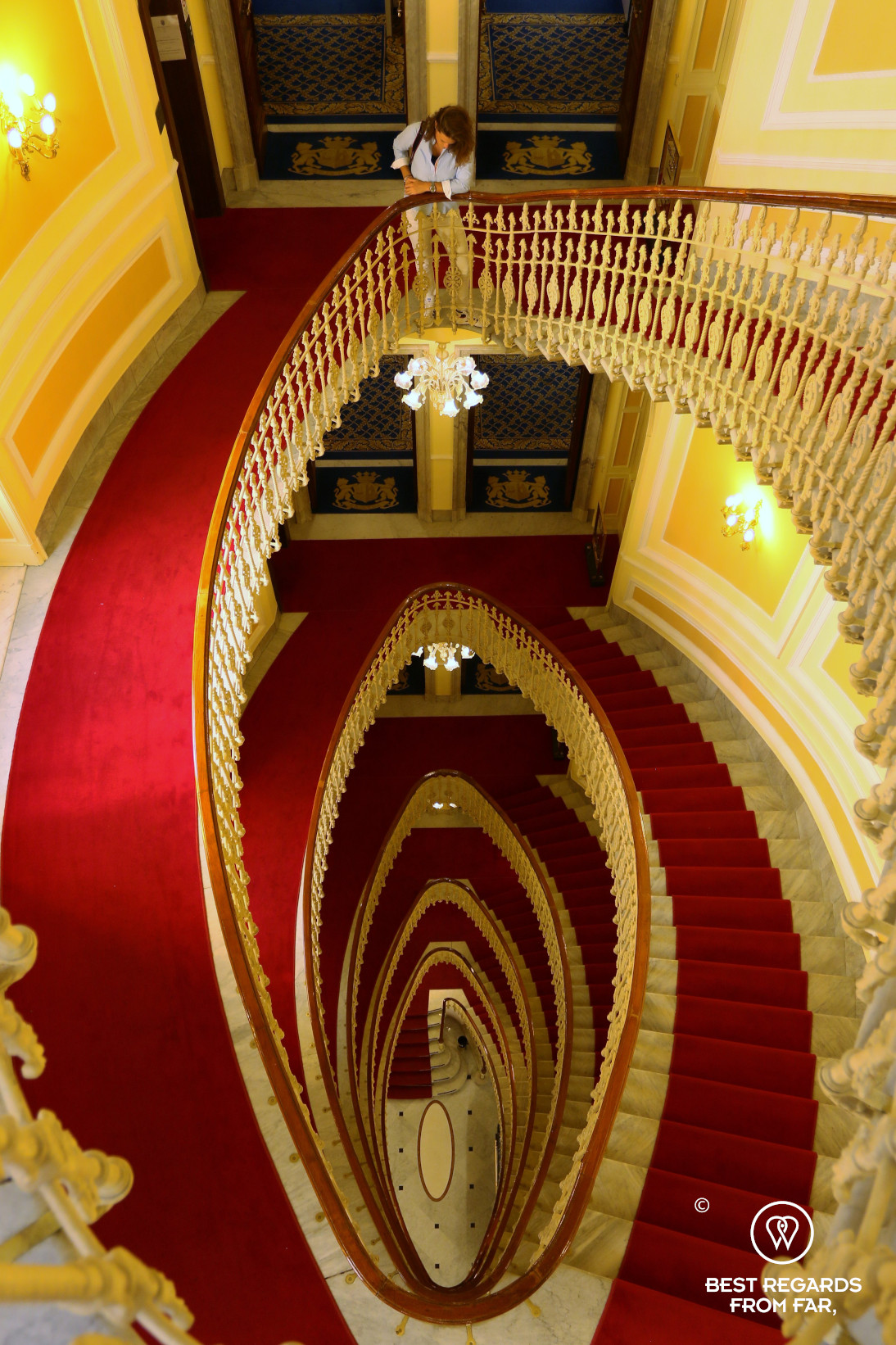
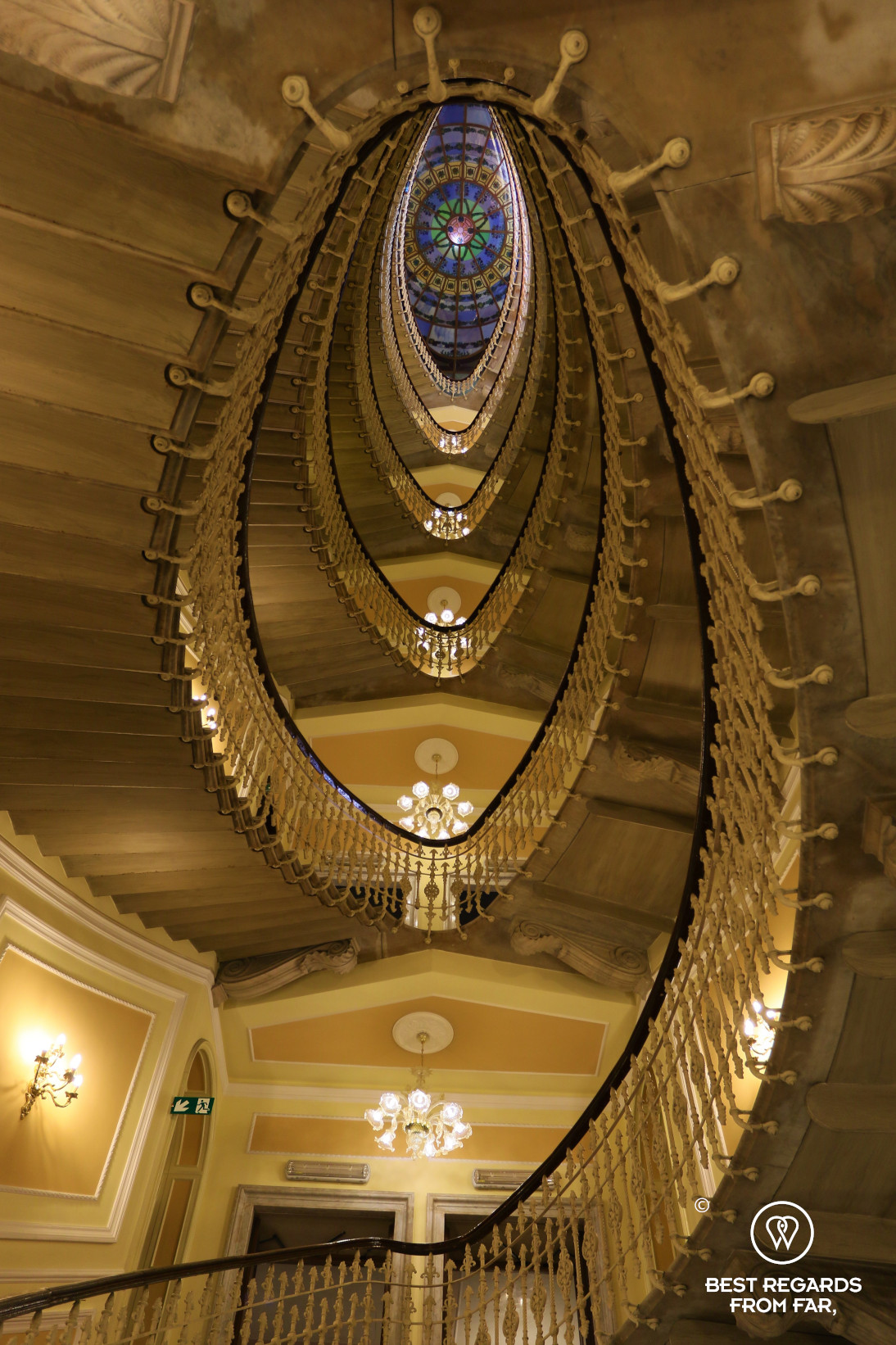



The hotel has been beautifully restored with its hardwood and marble floors, stuccoes and frescoes, elegant chandeliers and precious classic furniture. A member of “Historical Places of Italy”, sponsored by the Italian Ministry of Heritage and Culture, the hotel Bristol Palace is part of the Italian-owned Duetorrihotels Group.
Walking the caruggi
Caruggi are the narrow alleyways in the medieval centre of Genoa leading to the harbour. All sorts of trades used to take place in these shady streets, dodgy for the most part. Many current buildings used to be medieval warehouses, simply built over and still showcasing their high ceilings and arches. During the Middle Ages, the city was organized by trades, and the street names such as butcher’s or lace’s street reveal in which area you are. Walk the maze of caruggi to discover little gems, precious shops that have been open for centuries, hidden churches, sculpted details on façades and soak in the atmosphere of Genoa.


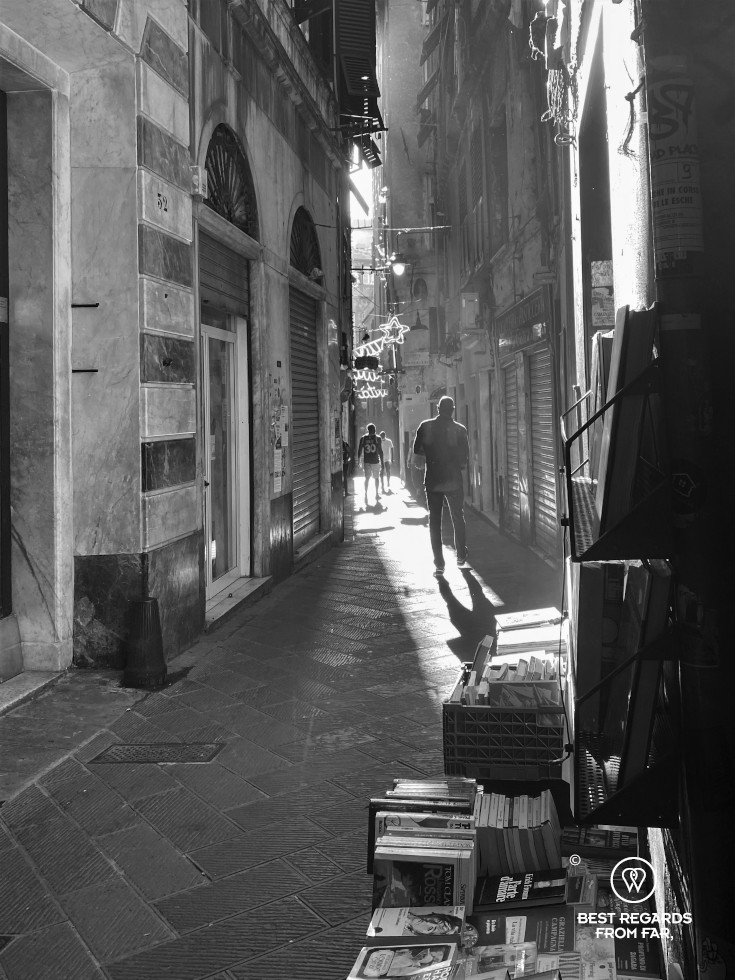
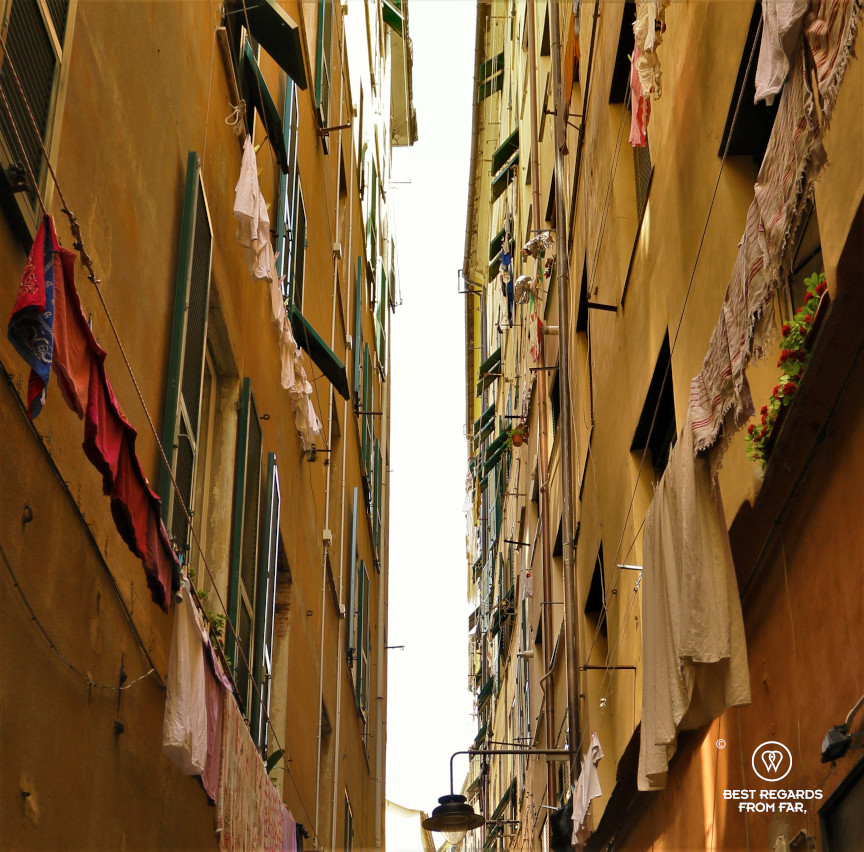

Here are some of the highlights:
Drogheria Torielli [spice shop]
In this wonderful drogheria that was created in 1930 you can still buy anything that you used to find in old fashioned drogherias: teas, all sorts of spices, herbs, drinks, coffee, and a wide variety of products presented in old wooden cabinets and glass jars. Make sure to stop by and travel back in time.
Antico Forno della Casana [Focaccia time]
The specialised bakery has been supplying locals with some of the best focaccia and grissini in town. The focaccia is best eaten fresh, and you will be recognized as a Genoese if you dip it in your cappuccino for breakfast.

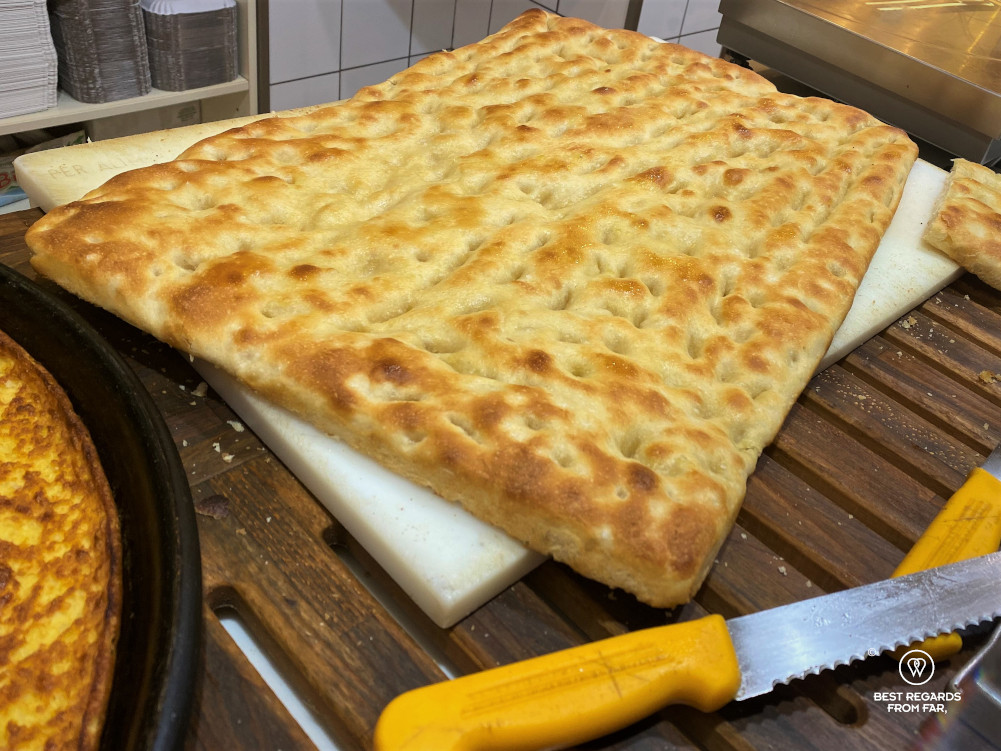

Antico Barberia [for a shave in the backstreets]
To experience a traditional shave, make sure to walk in this historical barber shop, founded in 1882. It has been restored, and even if you don’t need a shave, check it out for its fantastic art deco décor.
Cremeria Buonafede [sweet tooth]
Obviously, Italian ice creams are a must when visiting the peninsula. There is one flavour though that can be found only in Genoa: panera. It is a semi-freddo cream that is coffee flavoured and tastes a bit like cappuccino, and that is just so much better that any cappuccino-flavoured ice cream you may have tried! Locals love it and eat it all year round, especially the one from Cremeria Buonafede, that has been offering the best in town since 1913.



Confetteria Pietro Romanengo [to bring back sweet souvenirs]
Situated on the wider Via di Soziglia, the sweet tradition of this store dates back to 1814 when it first opened its doors. The craftmanship of creating the most refined candies has been passed down for 7 generations and the store has kept its charm with its antique décor. The beautifully hand-made confectionaries are deeply rooted in the Genoese culture and are definitely the sweetest souvenir to bring back from Genoa!



Discovering hidden gems: the churches of Genoa
If a doge was in charge of La Superba from his Palazzo Ducale, his power was limited as the real rulers were a few influential Genoese families. Every family was living in its palace with its own church built on a square where discussions took place in this sub-centre of power. To show off their power and wealth, towers were built (even if there are only 5 left out of 65). Make sure to visit the following three churches during your visit:
- San Matteo was the headquarter of the Doria family, and Andrea Doria its most illustrious member is buried in the San Matteo gothic church that was built in the 12th century.
- The Chiesa di Santa Maria di Castello is located in the oldest part of town, where a fortified castle once stood. The church was founded in 900 AD and showcases exquisite artworks that were collected by the main noble families, and depicting every historical period. This wonderful church is completely off the beaten path and a true gem to explore with its many chapels and hidden gardens.
- The San Lorenzo Cathedral with its layers of white Carrara marble and black slate is the seat of the Archbishop of Genoa. This impressive cathedral, built between the 11th and 14th century offers some stunning ceiling frescoes and 14th-century Byzantine style frescoes.








Via Garibaldi: 250 meters of UNESCO World Heritage
Genoa developed greatly during the crusades. Thousands were drawn to the city where they rested before embarking for departure and recovered once back. As the city grew fast, urban planning was necessary. During the Renaissance the aristocracy built the Via Garibaldi (originally named Strada Nuova) lined up with Genoa’s most extravagant palaces, showcasing the rich and glorious past of Genoa. Take your time to stroll this pedestrian-only part of town and make sure to step inside a few of these palaces:

Palazzo Baldassarre Lomellini a a design store in a 16th century palace
Garibaldi 12 is a design store housed in the Palazzo Baldassarre Lomellini. Every room is dedicated to a specific theme where cherry-picked objects have been chosen by the Bagnara family who has restored the palace. The décor is exquisite with frescoes and ceiling paintings by prominent artists: the 18th century Roman Scenes by Andrea Semino, or “Dido and Aeneas” by Gio have survived the alterations to the palace over the years.



Palazzo Bianco: a magnificent painting collection in a Rolli Palace
Rolli Palaces are ancestors to the Michelin Guide. These were mansions that were ticking all the required boxes in order to potentially receive the emperor, kings or ambassadors. It was a true honour for families back then to house these noble men and no penny was saved to show off their wealth.
In the 16th century, some of the most renown painters were called to Genoa by the leading families such as the influential Doria’s to ornate their palaces. Local artists like Luca Cambiaso and Giovannini Battista Castello got inspired and for over two centuries palaces and altarpieces of private chapels of the Genoese aristocrats competed for the most beautiful arts and fresco vaults. Their bright saturated greens, reds and blues, their use of light and the use of open landscapes as backgrounds have been inspiring the whole of Italy and beyond. The school of the Lombard Caravaggio active in Rome was also highly sought after for his innovative truthful representation of biblical scenes.


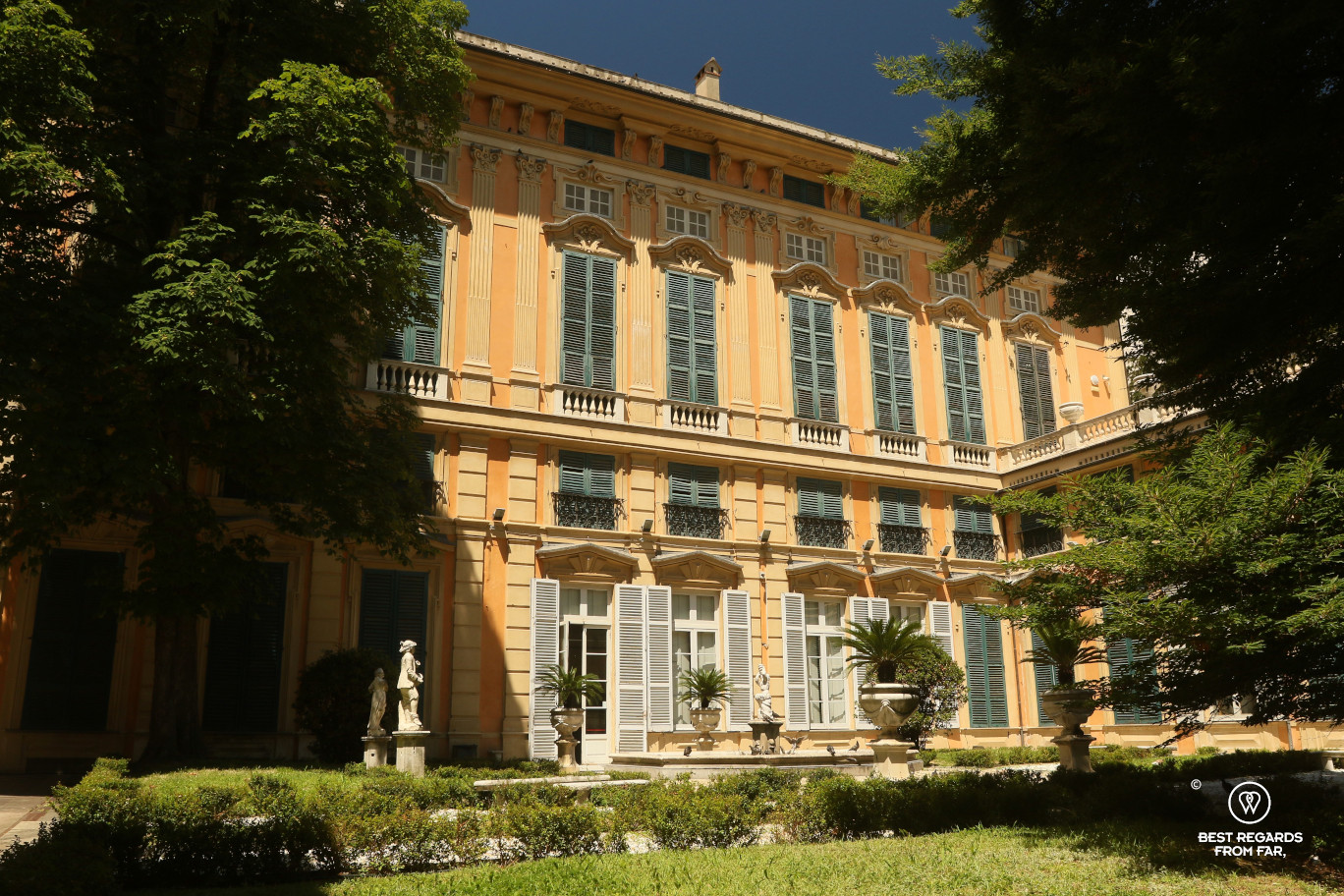

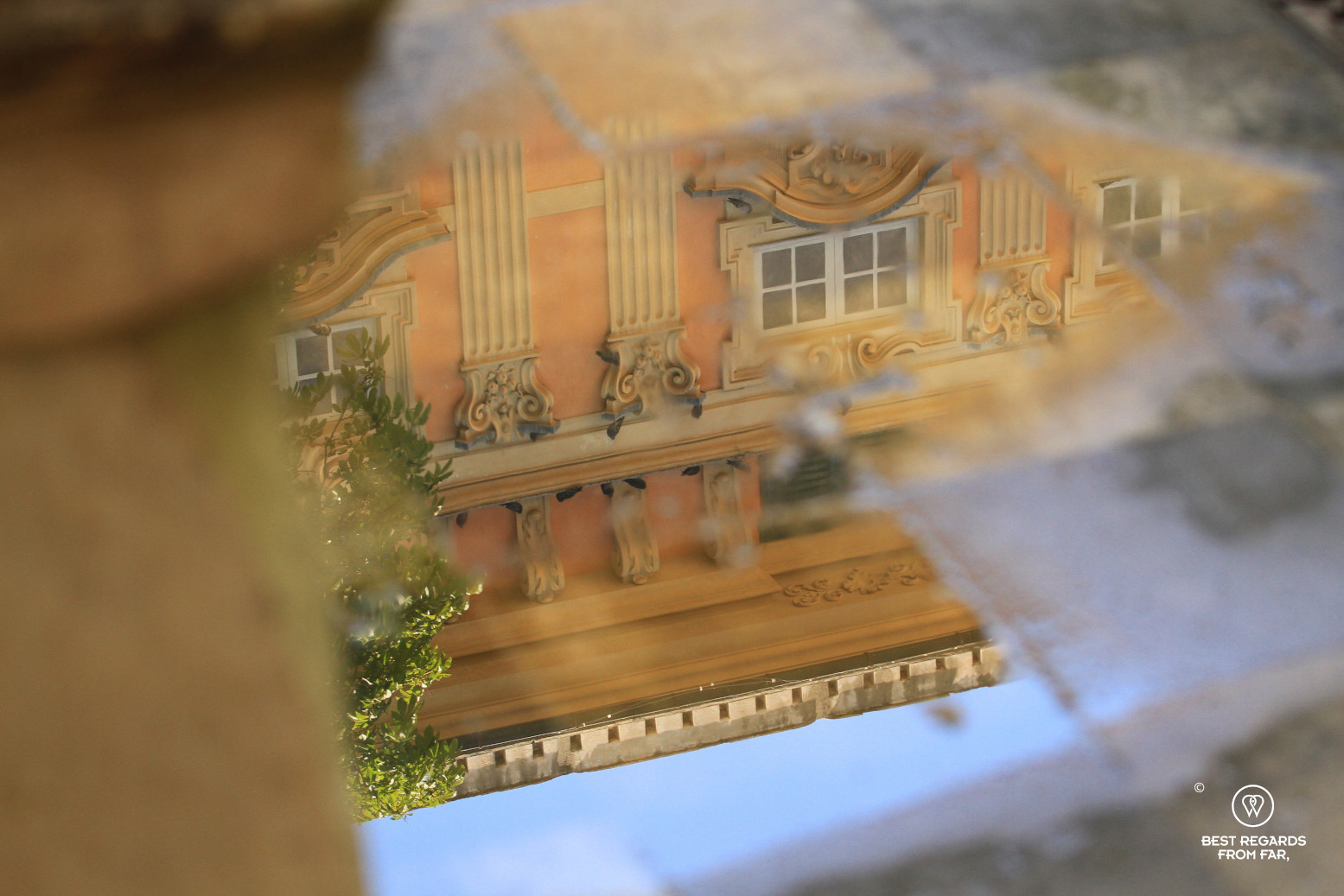
The early 16th century Palazzo Bianco showcases some of the best art of the time found in Genoa. The opposite Palazzo Rosso is well worth a visit as well and focusses on fantastic 17th century frescoes. This Genoese aristocratic building houses some precious furnishings and large painting collection.
Belvedere Luigi Montaldo
For a sweeping view over the city and its harbour, head to the Belvedere Luigi Montaldo. It is only a short (and steep) walk from the UNESCO World Heritage site of Via Garibaldi. Sunset is the best moment!
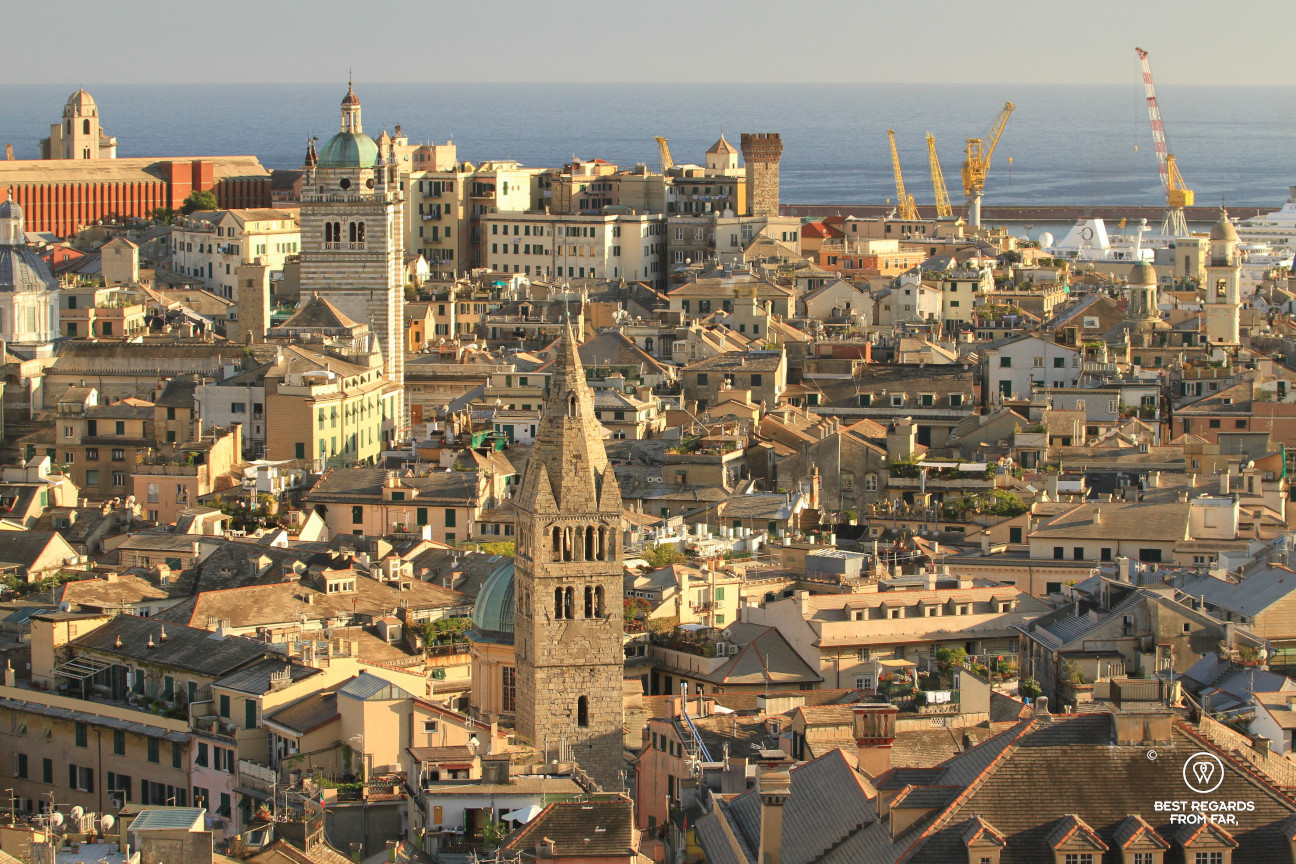
Palazzo Reale: discover a lavish 17th century royal residence
Not situated along the famous Via Garibaldi but closer to the harbour instead, this 17th century palace was built by the Genoese Balbi family between 1643 and 1650. In 1679, the Durazzo family took it over and inhabited the first floor while the second one was destined for ceremonies and banquets. The palace owes its name to the royal family of the Savoy, kings of Italy, who were the last to live here in the 19th century. They made the extravagant second noble floor their living quarters. The palace had been evolving constantly and the stucco-decorated vaults, walls and furniture show a harmonious combination of Baroque, Rococo and Neoclassical styles. Works of art include a Van Dyck and the copy of a Veronese making it a not-to-be-missed museum.


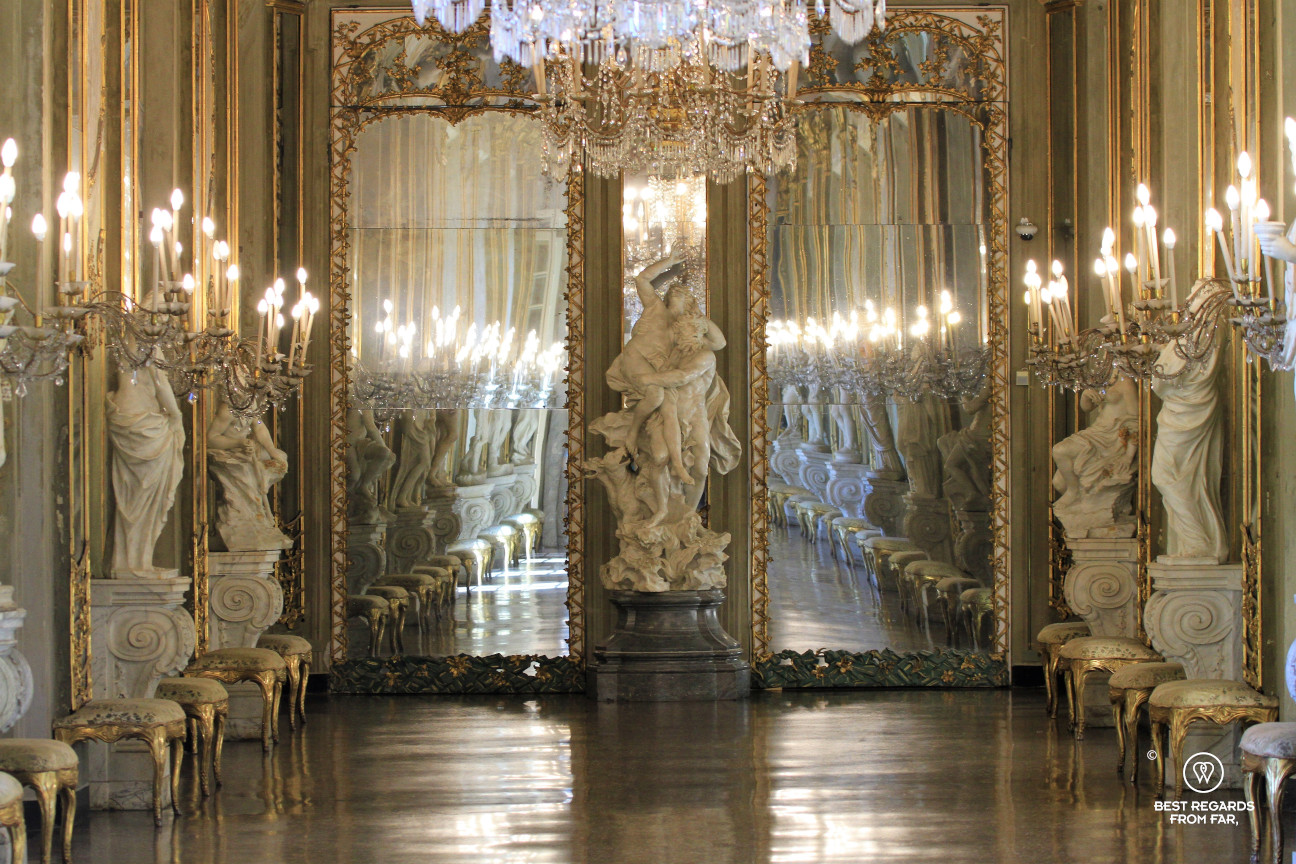


The throne room is one of the most impressive ones where a lion wearing a feathered helmet throwing down a snake can be spotted as the emblem of the Savoys, as well as the ever-present red and gold royal colours.
The Gallery of the Mirrors, designed by the Durazzo family to celebrate their own social status is the most beautiful room.
Mercato Orientale: an authentic food market
The main market of Genoa is open all day and makes space for Ligurian food. With raids by pirates from North Africa influencing the history of Genoa, the Ligurian cuisine is not based on seafood that much as fishermen were regularly abducted as manpower for the galleys. With an inhospitable terrain, between the Alps and the Apennine Mountains, there was not too much space for livestock, nor to cultivate wheat. As a consequence, the Ligurian gastronomy is based on olive oil and a rather vegetarian diet in which chickpea and chestnut flours were the staple food. Today, the centre of the Mercado Orientale is a food court where you can taste local specialties. Here is a list of some to try while in Genoa:
- Panissa: fried chickpea flour – a filling snack.
- Focaccia: Liguria is home to the well-known Italian flatbread and a local’s daily favourite.
- Pesto alla Genovese: what’s in a name? Pesto was born in this town!
- Taggiasche olives: the traditional Ligurian olives, small and tasty.
- The local minestrone soup, a thick soup with pastas.
- Torta pasquanina: a pie with thin layers of dough (traditionally 33 for Easter!) and filled with chards, artichokes or soft sour cheese.
- Trofie is the Ligurian handmade pasta traditionally served with Genoese pesto.
- Pansoti: pasta filled with wild early spring herbs.
- Ripieni: zucchini stuffed with eggs, herbs and Parmesan cheese.
- Polpettone: meatloaf with potatoes and green beans.


Close to the market, the restaurant Il Genovese is the perfect place to taste Ligurian specialties that have been honoured by its owner (and organizer of the pesto world championship), Roberto Panizza for years.
Explore Genoa’s redeveloped trendy harbour
Genoa went through a major urban redevelopment in 1992 to celebrate the 500th anniversary of the discovery of America by its most famous local: Christopher Columbus. The waterfront was redesigned by another prominent Genoese, the world-famous architect Renzo Piano. If the highway still cuts the city from its seafront, this project reconnected its inhabitants to the harbour. The Cotton Warehouses have been turned into a trendy spot with bars, restaurants and cinemas with amazing views on the city. They have become one of the places to be for locals and tourists alike. The harbour is also a popular place for a run or simply a stroll.





The aquarium of Genoa
The aquarium is situated on the century-old wharf of Ponte Spinola and houses Europe’s largest exhibition of aquatic biodiversity in a total of 71 tanks. From its rooftop you can enjoy fantastic views over the old harbour and the city of Genoa itself.
The Galata Maritime Museum
Explore the history of the maritime republic of Genoa from the seaside. The museum is housed in the longest-standing structure in Genoa’s old Darsena where its galleys were built, repaired and fitted. The specificities of the harbour allowed Genoa to cater for larger ships, hence develop more than other competing Mediterranean ports. This interactive museum also offers you the opportunity to get on board of a submarine that is stationed next to it.
Shopping in style along the Via XX Settembre
The Via XX Settembre is famous for its wide variety of boutiques and arts stores set in beautiful buildings. Some of Genoa’s most alluring façades can be found here and the covered arcades make strolling this street unique. A monumental bridge crosses this wide street from where you will have a greet view on this long boulevard.


Aperitivo on a square
The Italian equivalent to happy hours is aperitivo. Often between 7pm and 9pm locals relax over a glass of wine, a beer or a spritz while enjoying some pre-dinner snacks. Amidst the caruggi, some inviting squares are lined up with bars and restaurants. Piazza del Erbe and Piazza Lavagna are our favourites. The latter has been part of an urban redevelopment project to clean up the dodgy area from prostitution and drug dealing. It has worked very nicely and this airy square hosts several trattorias that are unbeatable for aperitivo after a day of exploring this vibrant city.
Boccadasse: a swim in the Ligurian Sea
While the West side of Genoa is very industrial with its shipyards and steelworks, its East side is residential. If you do not have time to further explore the Italian Riviera, then make sure to hop on a train to visit the picturesque old fishermen village of Boccadasse. Enjoy the colourful houses lined up by the small harbour, savour some local food and go for a swim.





Travel tips:
- To explore Genoa, refer to BeautifuLiguria, an Italian-based boutique tour operator that crafts unique tailor-made travel experiences.
- To explore Genoa, stay at the Hotel Bristol Palace.
- Want to have access to this article while walking the city? Download it through GPSmyCity and avoid roaming costs while exploring the city at your pace! Already have the app? Check the mobile version of this article here.
- Check out this interactive map for the specific details to help you plan your trip and more articles and photos (zoom out) about the area! Here is a short tutorial to download it.
For more in Genoa & Italy:
